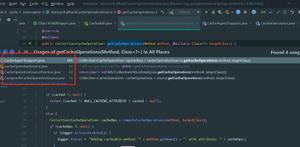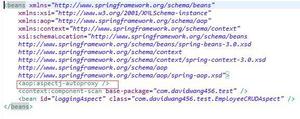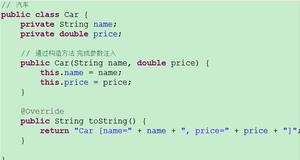【spring】--Bean作用域
本文内容纲要:【spring】--Bean作用域
Spring框架功能强大,其中一个常用的功能是使用IOC容器来管理Bean,在创建Bean的过程中,主要有5中作用域,下面就来介绍一下每一个作用域的特点和作用。
1、Singleton:设置为该模式的Bean,容器初始化时就创建一个Bean实例,而且该实例只存在一份。测试如下:
创建SingleScope类:
public class SingleScope { //创建空构造函数,用于测试IOC容器初始化时就创建该实例bean
public SingleScope(){
System.out.println("Constructor go ---->");
}
}
配置spring的配置文件ApplicationContext-scope.xml:
<?xml version="1.0" encoding="UTF-8"?><beans xmlns="http://www.springframework.org/schema/beans"
xmlns:xsi="http://www.w3.org/2001/XMLSchema-instance"
xsi:schemaLocation="http://www.springframework.org/schema/beans http://www.springframework.org/schema/beans/spring-beans-2.0.xsd
">
<!--配置bean,设置为singleton模式-->
<bean id="singleScope" class="com.wpb.scope.SingleScope" scope="singleton"/>
</beans>
创建测试类:
public class ScopeTest { public static void main(String[] args) {
ApplicationContext context=new ClassPathXmlApplicationContext("ApplicationContext-scope.xml");
SingleScope singleScope= (SingleScope) context.getBean("singleScope");
SingleScope singleScope1= (SingleScope) context.getBean("singleScope");
System.out.println(singleScope==singleScope1);
}
}
结果如下:
需要注意的是:spring中bean的singleton模式与设计模式中的单例模式是两个不同的概念,他们是有相同的特点,只实例一次。但是设计模式中的单例模式指的是ClassLoader加载该类时,只实例化一次。而bean的singleton模式指的是Spring IOC容器中只存在一份该bean。
2、Prototype:可以存在多个bean实例,容器初始化时不会创建bean实例,使用时才会创建。来看一下测试代码:
创建PrototypeScope类:
/** * Created by 王朋波 on 16/07/2017.
*/
public class PrototypeScope {
public PrototypeScope(){
System.out.println("PrototypeScope constructor go --->");
}
}
在spring的配置文件中添加如下配置:
<!--配置bean,设置为Prototype模式 --> <bean id="prototypeScope" class="com.wpb.scope.PrototypeScope" scope="prototype"/>
测试代码:
//当使用bean时,才创建实例。执行完下述获取实例语句,PrototypeScope中的构造函数才会执行 PrototypeScope prototypeScope= (PrototypeScope) context.getBean("prototypeScope");
PrototypeScope prototypeScope1= (PrototypeScope) context.getBean("prototypeScope");
System.out.println(prototypeScope==prototypeScope1);
运行结果:
注意的地方:Prototype bean被spring容器配置、装载、实例化之后,其生命周期将由自己负责,也就是spring容器不再管理它的生命周期,交给了客户端进行管理。
比较常用的是singleton和Prototype,下面三种不常用,简单了解一下基本概念和配置方式。
3、request:对于每次HTTP请求,使用request定义的Bean都将产生一个新实例,即每次HTTP请求将会产生不同的Bean实例。仅在基于web的Spring ApplicationContext情形下有效。
4、session:对于每次HTTP Session,使用session定义的Bean豆浆产生一个新实例。仅在基于web的Spring ApplicationContext情形下有效。
5、每个全局的HTTP Session,使用session定义的Bean都将产生一个新实例。典型情况下,仅在使用portlet context的时候有效。仅在基于web的Spring ApplicationContext情形下有效。
上述三种方式除了配置spring的配置文件之外,还需要在web.xml文件增加一个监听设置,如下:
<listener><listener-class>org.springframework.web.context.request.RequestContextListener</listener-class>
</listener>
小结:
bean的作用域中,需要重点掌握Singleton和Prototype两种方式,另外还需要与Struts2中配置Action时,也有这两种模式作对比,明白各自的含义以及默认使用。
本文内容总结:【spring】--Bean作用域
原文链接:https://www.cnblogs.com/victor-grace/p/7253609.html
以上是 【spring】--Bean作用域 的全部内容, 来源链接: utcz.com/z/362412.html









